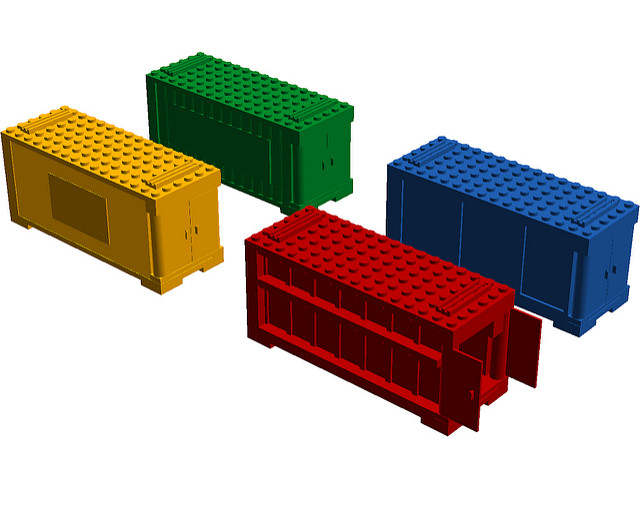Building Docker images with a Dockerfile
Building Docker images with a Dockerfile

Objectives
We will build a container image automatically, with a Dockerfile.
At the end of this lesson, you will be able to:
-
Write a
Dockerfile. -
Build an image from a
Dockerfile.
Dockerfile overview
-
A
Dockerfileis a build recipe for a Docker image. -
It contains a series of instructions telling Docker how an image is constructed.
-
The
docker buildcommand builds an image from aDockerfile.
Writing our first Dockerfile
Our Dockerfile must be in a new, empty directory.
- Create a directory to hold our
Dockerfile.
$ mkdir myimage
- Create a
Dockerfileinside this directory.
$ cd myimage
$ vim Dockerfile
Of course, you can use any other editor of your choice.
Type this into our Dockerfile…
FROM ubuntu
RUN apt-get update
RUN apt-get install figlet
-
FROMindicates the base image for our build. -
Each
RUNline will be executed by Docker during the build. -
Our
RUNcommands must be non-interactive.
(No input can be provided to Docker during the build.) -
In many cases, we will add the
-yflag toapt-get.
Build it!
Save our file, then execute:
$ docker build -t figlet .
-
-tindicates the tag to apply to the image. -
.indicates the location of the build context.
We will talk more about the build context later.
To keep things simple for now: this is the directory where our Dockerfile is located.
What happens when we build the image?
The output of docker build looks like this:
.small[
docker build -t figlet .
Sending build context to Docker daemon 2.048kB
Step 1/3 : FROM ubuntu
---> f975c5035748
Step 2/3 : RUN apt-get update
---> Running in e01b294dbffd
(...output of the RUN command...)
Removing intermediate container e01b294dbffd
---> eb8d9b561b37
Step 3/3 : RUN apt-get install figlet
---> Running in c29230d70f9b
(...output of the RUN command...)
Removing intermediate container c29230d70f9b
---> 0dfd7a253f21
Successfully built 0dfd7a253f21
Successfully tagged figlet:latest
]
- The output of the
RUNcommands has been omitted. - Let’s explain what this output means.
Sending the build context to Docker
Sending build context to Docker daemon 2.048 kB
-
The build context is the
.directory given todocker build. -
It is sent (as an archive) by the Docker client to the Docker daemon.
-
This allows to use a remote machine to build using local files.
-
Be careful (or patient) if that directory is big and your link is slow.
Executing each step
Step 2/3 : RUN apt-get update
---> Running in e01b294dbffd
(...output of the RUN command...)
Removing intermediate container e01b294dbffd
---> eb8d9b561b37
-
A container (
e01b294dbffd) is created from the base image. -
The
RUNcommand is executed in this container. -
The container is committed into an image (
eb8d9b561b37). -
The build container (
e01b294dbffd) is removed. -
The output of this step will be the base image for the next one.
The caching system
If you run the same build again, it will be instantaneous. Why?
-
After each build step, Docker takes a snapshot of the resulting image.
-
Before executing a step, Docker checks if it has already built the same sequence.
-
Docker uses the exact strings defined in your Dockerfile, so:
-
RUN apt-get install figlet cowsay
is different from
RUN apt-get install cowsay figlet -
RUN apt-get updateis not re-executed when the mirrors are updated
-
You can force a rebuild with docker build --no-cache ....
Running the image
The resulting image is not different from the one produced manually.
$ docker run -ti figlet
root@91f3c974c9a1:/# figlet hello
_ _ _
| |__ ___| | | ___
| '_ \ / _ \ | |/ _ \
| | | | __/ | | (_) |
|_| |_|\___|_|_|\___/
Yay! .emoji[🎉]
Using image and viewing history
The history command lists all the layers composing an image.
For each layer, it shows its creation time, size, and creation command.
When an image was built with a Dockerfile, each layer corresponds to a line of the Dockerfile.
$ docker history figlet
IMAGE CREATED CREATED BY SIZE
f9e8f1642759 About an hour ago /bin/sh -c apt-get install fi 1.627 MB
7257c37726a1 About an hour ago /bin/sh -c apt-get update 21.58 MB
07c86167cdc4 4 days ago /bin/sh -c #(nop) CMD ["/bin 0 B
<missing> 4 days ago /bin/sh -c sed -i 's/^#\s*\( 1.895 kB
<missing> 4 days ago /bin/sh -c echo '#!/bin/sh' 194.5 kB
<missing> 4 days ago /bin/sh -c #(nop) ADD file:b 187.8 MB
Introducing JSON syntax
Most Dockerfile arguments can be passed in two forms:
-
plain string:
RUN apt-get install figlet -
JSON list:
RUN ["apt-get", "install", "figlet"]
We are going to change our Dockerfile to see how it affects the resulting image.
Using JSON syntax in our Dockerfile
Let’s change our Dockerfile as follows!
FROM ubuntu
RUN apt-get update
RUN ["apt-get", "install", "figlet"]
Then build the new Dockerfile.
$ docker build -t figlet .
JSON syntax vs string syntax
Compare the new history:
$ docker history figlet
IMAGE CREATED CREATED BY SIZE
27954bb5faaf 10 seconds ago apt-get install figlet 1.627 MB
7257c37726a1 About an hour ago /bin/sh -c apt-get update 21.58 MB
07c86167cdc4 4 days ago /bin/sh -c #(nop) CMD ["/bin 0 B
<missing> 4 days ago /bin/sh -c sed -i 's/^#\s*\( 1.895 kB
<missing> 4 days ago /bin/sh -c echo '#!/bin/sh' 194.5 kB
<missing> 4 days ago /bin/sh -c #(nop) ADD file:b 187.8 MB
-
JSON syntax specifies an exact command to execute.
-
String syntax specifies a command to be wrapped within
/bin/sh -c "...".
When to use JSON syntax and string syntax
-
String syntax:
- is easier to write
- interpolates environment variables and other shell expressions
- creates an extra process (
/bin/sh -c ...) to parse the string - requires
/bin/shto exist in the container
-
JSON syntax:
- is harder to write (and read!)
- passes all arguments without extra processing
- doesn’t create an extra process
- doesn’t require
/bin/shto exist in the container